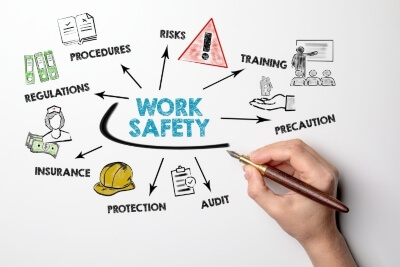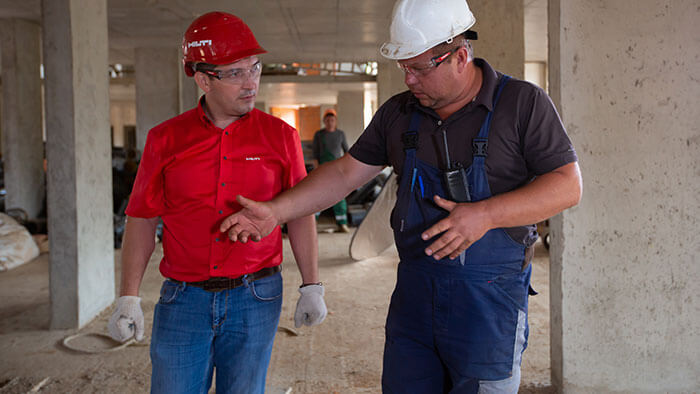7 Tips for an Effective JHSC Inspection, from a Safety Trainer’s Perspective
Sep 25, 2019 JHSC, Workplace InspectionsNo one likes when a favourite colleague leaves their organization, especially when they happen to be on the Joint Health and Safety Committee. So the inevitable happens, that you are voluntold… I mean volunteered to replace them on said committee – now what? Go to meetings? Resolve work refusals? Perform inspections? Well yes, all of those are required duties as per the Occupational Health and Safety Act. However the first two are topics for another day, we are here to talk about committee inspections. I clearly remember my first inspection, and in hindsight I can admit I was woefully unprepared. I did not fully understand what I was to be looking for besides “hazards.” What type of hazards? What constitutes a hazard? How bad does it really have to be? All questions circling my mind when given this task. The following seven tips are things I have learned along the way that could have streamlined my ability to establish an effective workplace inspection.
Tip #1 – Understand existing controls
Before you embark on your first workplace inspection, it would be a good idea to review your organization’s Health and Safety program. You know the group of neglected binders on a shelf in the back office? Yes, that one. What a Health and Safety program review will offer you, is that it covers what the existing controls are. It is a comprehensive list of what hazards are currently in the workplace, and what the employer is doing to protect workers from them. It is a great starting point because it is a rudimentary list of what you will expect to find. The added benefit of knowing what controls are currently in place is that you can also check their effectiveness. What works in one area might be able to be applied elsewhere. If they are not working – then boom! Hazard.
Tip #2 – Deviations of SOPs
The next step in your preparation should be learning the expectations. Most organizations have standard operating procedures or SOPs. These list out the job task, the stages/phases/steps, expected duration, and quality checks. I am sure we have all been trained to follow the instructions when completing our work to achieve to desired outcome. In an acceptable time of course. Most SOPs are used for performance management. However as a committee member you can use them to see if the company specified process is being followed. As an employer has the ultimate duty to protect the worker, controls are built into each step. Deviations from the steps mean deviations from hazard controls. Knowing what should be done helps you spot what people ignore – complacency? Boom! Hazard.
Tip #3 – Unsafe Practices
Now following the first two tips should give you a rather thorough understanding about what the employer has found, and what they are doing to control it. The next thing is to look for holes in the proverbial armour. Knowing what has already been recognized, will make what has not been identified stand out. Your organization may have areas with accepted levels of risk that are not truly addressed or even areas where you notice that there are no controls. Permitting what appear to be unsafe practices could be a legacy of days gone by or that old school mentality that your current safety culture is designed to curb. I find that people have a tendency to bring in their bad habits acceptable at home into the workplace. If you see this transitionary behaviour occurring at your organization – Boom! Hazard.
Tip #4 – Lack of Standardization
Now after that careful review, you will have policies and procedures coming out of your ears. You should be able to look at a job task in your workplace and have a basic understanding of what is expected. The ability to predict what others in the workplace will do next is how we as individuals keep ourselves safe. The next item on our list to consider is what has not been by the employer. Now I’ll reference the phrase that makes every committee member shudder, “common sense.” You might see that your organization controls all of the significant or obvious hazards, but something, like lifting a box, or changing out an empty container, might have been overlooked. Most employers do not want to spend the time to write a procedure for simple things. They hired adults! However this lack of standardization leads people to decide how they will complete these tasks. There is a reason the musculoskeletal disorders (MSDs) are the top claim according to the WSIB. Something, like lifting or even sitting, is something we do all the time, its – wait for it “common sense.” Alternatively, see an empty container that needs changing? No different. Things that are small tasks, not revenue generating, or perhaps even seen as trivial need to be addressed to protect the worker. No basic guidance given for expected tasks? Boom! Hazard.

Tip #5 – Talk to Workers
Before being on the committee, have you ever wondered what they were doing when they entered a room? They seem to stroll around, make some notes and leave. Now I am rather chatty, but I have always felt like the person doing the inspection was focused and did not want to be bothered. That has been my experience anyway. The biggest asset for a committee member doing an inspection is the workers themselves. Use your ability to interview workers in every area you are inspecting. You are in the areas for a few minutes; they are there all day. Your perspective is simply that, yours. Others may find what you have overlooked. If there is something that needs to be examined, they will tell you. If the committee gets their issue resolved, they will continue reporting. Communication is essential in establishing credibility for the committee – you have to show you add value to workers. If they believe you are wasting their time, do not expect much in terms of participation in your inquiries. A good rule is for every 45 minutes of inspection time, set aside 15 minutes for interviews. When they tell you about the loose racking that was not reported – Boom! Hazard.
Tip #6 – Look for more than the Obvious
The next tip requires spending more time watching work in progress, or people in operation. Look beyond the superficial incomplete pre-use inspection sheet or small pile of water beside the garbage bin. Watch the organization run. Your power of observation and your existing knowledge of the controls as per the Health and Safety program should show consistency and cooperation. In reality we are aware that not all of which is required, is done all the time. Use your sight; people may be driving with raised forks or lifting with their back. Your sense of touch to see if something is vibration when it should not. Ears will pick up the often-overlooked psychosocial issues such as malicious gossip. Your sense of smell might pick up chemicals mixed over the recommended concentrations. Your sense of taste? Well let us not go licking things, but you can taste if the air quality might need further consideration. Do not forget about our sixth sense, if you are doing an inspection and you are getting a weird vibe in a part of the facility – inspect further. Why did the conversation stop? Why are people overly clear about putting on PPE… perhaps it is not the typical behaviour when no one is around – Boom! Hazard.
Tip #7 – Compliance
Now, as a trainer I spend all day discussing compliance, but I have not always been in this role. As a worker I did not have an understanding of the Occupational Health and Safety Act and its Regulations. So does that mean I did not follow the law? Yes, sometimes, but more through ignorance than anything else. As a JHSC member doing an inspection, part of your role is to ensure that the internal responsibility system is functioning correctly. That means understanding how the law is to be manifested in your workplace. You should be looking for issues of noncompliance because there is a reason it is illegal. It has happened in the past, and learning for someone else’s mistake is a good idea. Spend time and learn the regulations of where you work. If your organization has ever received orders from the Ministry of Labour, you will know they look for compliance issues. Compliance issues equal the presence of well know hazards. So if you see a worker forget to wear their safety boots and hoping no one notices? Well that is O.Reg 851 S.82 – Boom! Hazard.
Following these seven tips will better help prepare you for your next inspection. The purpose is to document potential and actual hazards so that they can be addressed at the committee level. No one wants to have an incident in their workplaces for numerous reasons – injury being the top. So how in-depth has your committee been when completing their inspections? Remember an inspection is a proactive step in occupational health and safety. The investigation is reactive, an “oops, we missed something.” Not something we want at all! However, that is a topic for another day.
Geoff Rowatt | CHRP | Safety Trainer





